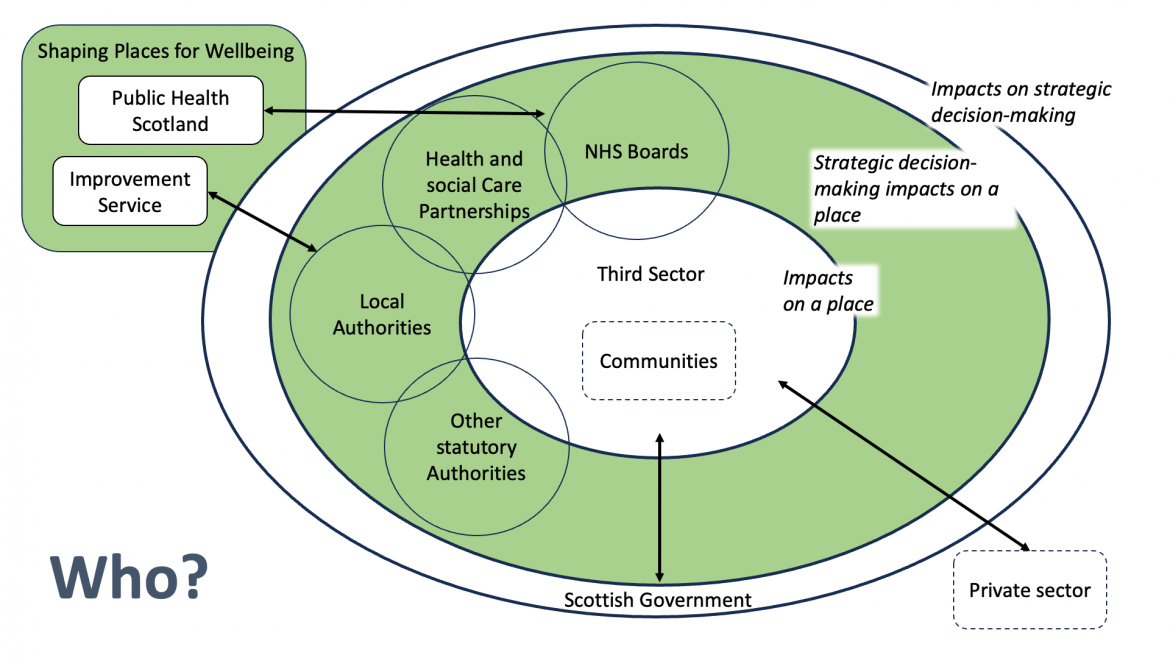The Shaping Places for Wellbeing Programme takes a whole system approach to our ambition to reduce inequality and improve health of people and planet. Through Local Project Action, we considered how the system operates and identified opportunities for changes in the system to achieve better outcomes.
A whole systems approach means recognising that reducing inequality and increasing wellbeing is a complex and shared issue and we need to think about all the parts of the system and how they work together. It is also about tackling the root causes of issues and embedding a preventative way of thinking.
The Programme considers the multiple and overlapping parts of the system that are involved in the decision-making landscape that impacts on place. This is reflective of who we work with and bringing together partners and organisations across health, planning, economic development and the third sector to deliver our ambition.
Through Local Project Action, the Programme has supported decision makers to take a place-based approach to create places that contain all the features that evidence tells us will have a positive impact. A whole systems approach complements this as it acknowledges that no aspect of place can be considered in isolation, and no single organisation can address all these features alone.
The way in which we think about the whole system is embedded in the Shaping Places for Wellbeing place-based approach in the following ways:
- Place – using the Place and Wellbeing Outcomes which highlight that every sector needs to be to working together to take actions that deliver all the Outcomes in every place.
- People – using a broad range of data including health, economy and environment to understand how people are impacted by inequality and what they need from their place.
- Decisions - how we support the process of decision-making and identify opportunities for collaboration and new ways of working that embed system change.

Some of the key parts of the system that we engaged with through the programme, with a particular focus on the area shaded in green and the third sector through our Local Project Action.
Systems change
The work of the Programme has involved developing an understanding of the system, identifying opportunities for testing out system change and highlighting levers for collaboration and new ways of working.
‘Systems change’ is described by New Philanthropy Capital (NPC):
‘Systems change aims to bring about lasting change by altering underlying structures and supporting mechanisms which make the system operate in a particular way. These can include policies, routines, relationships, resources, power structures and values.’
The Shaping Places for Wellbeing Programme aims to support lasting change in the understanding and contribution of our places to improving wellbeing. For our Programme, we believe success will see our partner organisations:
- With an increased understanding of the role of the Place and Wellbeing Outcomes to support the creation of places we live, work and relax in enabling wellbeing
- Expanding the role of place in their decision-making processes and policy
- Enhanced collaborative, cross-system partnership working
- Sharing learning about the consideration of place beyond the Project Town into other areas
Mechanisms of Change
Thinking about how system change can be driven by changes in routines, values, power sharing and relationships, the Programme reflected on how people having certain experiences, behaviours, attitudes, values and motivations when engaged in our activities helped to enable system change. We’ve referred to these as mechanisms of change. Mechanisms of change are the link between the activities delivered and the outcomes we hope to achieve. Based on our experiences delivering Local Project Action, we believe system change is more likely when these mechanisms of change are experienced.
- This document shares these mechanisms of change and summarises the work undertaken to capture them.
As part of the workstream on this, we also did some learning exercises to understand what people involved with the Programme perceived as working well or needing more support or time to develop.
Through the Local Project Town work and with the support of the Steering Groups, we developed our system thinking through:
- Creating a Theory of Change that identified drivers of change which the Programme could focus on and informed an implementation plan to test them out
- Mapping current and future ambitions of plans and strategies which impact on the Project Towns
- Mapping opportunities to bring the Outcomes and data into the decision-making process
- Testing out system change through Place and Wellbeing Assessments, which brought together organisations offering a starting process to support decision-makers in raising awareness of their impact on place
- Exploring ways with partners to embed recommendations from the Place and Wellbeing Assessments.
Our learning about a whole system approach and system change has been captured and shared in a number of ways to support the replication of the systems change work including:
- Blogs
- National and Local Learning Cohort
- Recommendations report
- Mechanisms of change report
- How to Guides
If the Shaping Places for Wellbeing place-based approach sounds like something you would like to know more about, please contact Irene Beautyman, Place and Wellbeing Partnership Lead, below. Alternatively, follow us on LinkedIn - Planning and Place-Based Approaches, to keep up to date with the Planning and Place-Based Programmes from within the Improvement Service, and X @place4wellbeing to recap on the Shaping Places for Wellbeing Programme’s journey.

Irene Beautyman - Place and Wellbeing Partnership Lead
Phone: 07908 930763
-
Planning for Place Programme
The Planning for Place Programme supports councils and their partners to collaborate around place, seeking to encourage place-based approaches to joint planning, resourcing and delivery of places that enable all communities to flourish.
-
National Planning Improvement Programme
The National Planning Improvement Champion is responsible for monitoring the performance of planning authorities and providing advice to them (and others) on what steps might be taken to improve their performance.
-
Planning Skills
The Planning Skills Programme co-ordinates training events for public sector planning officers, with the aim to develop the skills required to deliver better places.
-
Digital Planning
The Digital Planning team at the Improvement Service collaborates with local government to enhance and unify data related to planning and building standards. This work aims to develop a cohesive national data landscape, fostering insights and supporting informed decision-making.
-
Shaping Places for Wellbeing Place-based Approach
The Shaping Places for Wellbeing Programme is a joint delivery partnership between the Improvement Service and Public Health Scotland. This forum is for those interested in our work supporting the role of place to reduce inequality and improve the wellbeing of people and planet.
-
Place Network
For those interested in the importance of place as a working approach to delivering national outcomes around improved wellbeing and inclusive growth.